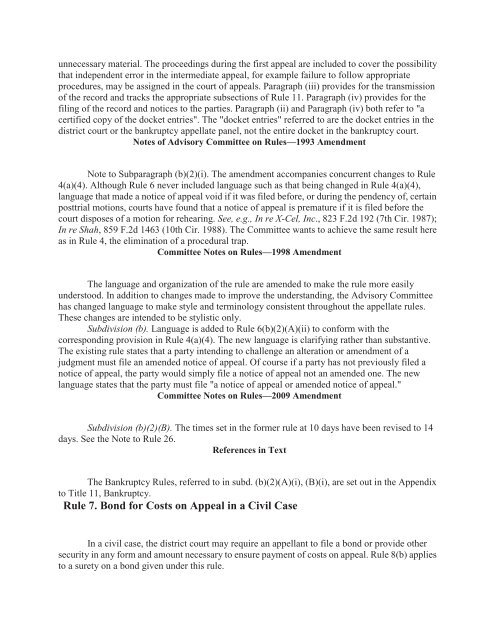Federal Rules of Appellate Procedure 2014-2015, 2014a
Federal Rules of Appellate Procedure 2014-2015, 2014a
Federal Rules of Appellate Procedure 2014-2015, 2014a
Create successful ePaper yourself
Turn your PDF publications into a flip-book with our unique Google optimized e-Paper software.
unnecessary material. The proceedings during the first appeal are included to cover the possibility<br />
that independent error in the intermediate appeal, for example failure to follow appropriate<br />
procedures, may be assigned in the court <strong>of</strong> appeals. Paragraph (iii) provides for the transmission<br />
<strong>of</strong> the record and tracks the appropriate subsections <strong>of</strong> Rule 11. Paragraph (iv) provides for the<br />
filing <strong>of</strong> the record and notices to the parties. Paragraph (ii) and Paragraph (iv) both refer to "a<br />
certified copy <strong>of</strong> the docket entries". The "docket entries" referred to are the docket entries in the<br />
district court or the bankruptcy appellate panel, not the entire docket in the bankruptcy court.<br />
Notes <strong>of</strong> Advisory Committee on <strong>Rules</strong>—1993 Amendment<br />
Note to Subparagraph (b)(2)(i). The amendment accompanies concurrent changes to Rule<br />
4(a)(4). Although Rule 6 never included language such as that being changed in Rule 4(a)(4),<br />
language that made a notice <strong>of</strong> appeal void if it was filed before, or during the pendency <strong>of</strong>, certain<br />
posttrial motions, courts have found that a notice <strong>of</strong> appeal is premature if it is filed before the<br />
court disposes <strong>of</strong> a motion for rehearing. See, e.g., In re X-Cel, Inc., 823 F.2d 192 (7th Cir. 1987);<br />
In re Shah, 859 F.2d 1463 (10th Cir. 1988). The Committee wants to achieve the same result here<br />
as in Rule 4, the elimination <strong>of</strong> a procedural trap.<br />
Committee Notes on <strong>Rules</strong>—1998 Amendment<br />
The language and organization <strong>of</strong> the rule are amended to make the rule more easily<br />
understood. In addition to changes made to improve the understanding, the Advisory Committee<br />
has changed language to make style and terminology consistent throughout the appellate rules.<br />
These changes are intended to be stylistic only.<br />
Subdivision (b). Language is added to Rule 6(b)(2)(A)(ii) to conform with the<br />
corresponding provision in Rule 4(a)(4). The new language is clarifying rather than substantive.<br />
The existing rule states that a party intending to challenge an alteration or amendment <strong>of</strong> a<br />
judgment must file an amended notice <strong>of</strong> appeal. Of course if a party has not previously filed a<br />
notice <strong>of</strong> appeal, the party would simply file a notice <strong>of</strong> appeal not an amended one. The new<br />
language states that the party must file "a notice <strong>of</strong> appeal or amended notice <strong>of</strong> appeal."<br />
Committee Notes on <strong>Rules</strong>—2009 Amendment<br />
Subdivision (b)(2)(B). The times set in the former rule at 10 days have been revised to 14<br />
days. See the Note to Rule 26.<br />
References in Text<br />
The Bankruptcy <strong>Rules</strong>, referred to in subd. (b)(2)(A)(i), (B)(i), are set out in the Appendix<br />
to Title 11, Bankruptcy.<br />
Rule 7. Bond for Costs on Appeal in a Civil Case<br />
In a civil case, the district court may require an appellant to file a bond or provide other<br />
security in any form and amount necessary to ensure payment <strong>of</strong> costs on appeal. Rule 8(b) applies<br />
to a surety on a bond given under this rule.


















